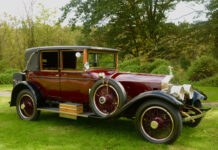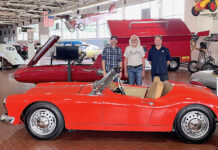By Jay Hirsch
The Muntz Jet owes its origins to two men: Frank Kurtis and Earl Muntz, both of whom had a vision of a “personal luxury car” long before the 1958 four-seat Thunderbird or the 1963 Buick Riviera.
The Muntz Jet began life as the Kurtis Sports Car in 1949. It was a two-seat sports car designed by Frank Kurtis and Sam Hanks and built by Frank Kurtis. Kurtis was known for building race cars — Midgets, Sprint Cars, and Indy cars. Kurtis built five cars that won the Indianapolis 500.
In 1948 Frank had a grand idea to build a sports car for the public. The undertaking turned out to be a little too much — as in too costly — for Frank. Only 15 Kurtis Sports Cars were built before production was stopped. The two-seater Kurtis Sports Car (KSC) had a wheelbase of 100 inches and was 169 inches long.
Earl “Madman” Muntz owned several used-car dealerships in Southern California, as well as a self-taught engineer and somewhat of an electronics genius. He made televisions when the television industry was in its infancy. It is said he coined the abbreviation “TV” for the word television.
Muntz wanted the Kurtis, not so much to make and sell a new sports car for the emerging post WWII car market, but to promote his used-car dealerships and his electronic store that sold T Vs. Muntz used flamboyant, comical ads on radio, billboards, and television to promote his used-car dealerships and portrayed himself as “a little mad for almost giving the cars away.”
When Muntz bought the design rights to the Kurtis Sports Car for $200,000 he stretched the wheelbase to 113 and the length of the car increased from 169 inches to 178 inches, so there could be a back seat, enabling the car to hold four passengers. It was re-named the Muntz Jet.
Race car driver Sam Hanks helped Muntz in this redesigning of the car from a two-seater to a more practical four-seater. Muntz said he used the word “Jet” as the new Jet aircrafts were just emerging and the word “Jet” symbolized speed.
When Frank Kurtis built his Kurtis Sports Car the engine was to be a Ford Flat Head V-8 that was modified for installing in the Kurtis. If the prospective buyer of the Kurtis did not want the Ford Flat head, this was no problem, as the Kurtis could be fitted with any motor and transmission of the customer’s choice. With a price of about $3,800 in 1949 dollars, potential owners were not lining up outside Mr. Kurtis’s office. To put this in some perspective, in 1950 a Ford convertible could be had for $1,900, and the new Jaguar XK 120 was $2,500.
When the Kurtis became the Muntz Jet the standard engine was to be the new OHV 331 cid V-8 Cadillac engine, or the new Oldsmobile OHV 303 V-8. Cadillac was not too excited about selling its new OHV V-8, so when Lincoln came out in 1952 with their new OHV V-8 it was more widely used in the Muntz Jets. The Muntz came with the GM Hydramatic. A Borg Warner three-speed manual was available as an option. Most Muntz Jets were ordered with the GM Hydramatic.
As for performance the Muntz had a top speed or 118 mph with 0-60 mph of nine seconds. In 1953 this was quite a feat!
The Muntz was not a convertible. There was no soft-top that folded down. The only top on the car was one made of Vitalite. This was a stiff vinyl-like material that was fitted over a lightweight aluminum frame. The top could easily be lifted off by two people. The top was available in either white or black.
The Muntz was not sold in dealerships but was a factory-direct car, which did not help in the overall sales of the car. The fact that the car was not made by any of the Big Three (Chrysler, Ford and GM) or any of the smaller independent American car companies did not help in trying to sell and market the Muntz.
The Muntz had an aluminum body and was made at various times in Glendale, Calif., and Evanston, Ill., from 1949 to 1954. In 1953 the price was $5,500 when a Cadillac convertible was $4,000 and a Lincoln convertible was $3,700. Supposedly it cost $6,500 to make the Muntz. This did not deter Muntz, as he saw the Jet as not only a good car for people but also as a marketing tool for his business empire of used-car dealerships and his burgeoning electronics/television stores.
The Muntz was only 54 inches tall and had a low center of gravity. This combination resulted in the car being very maneuverable at high speeds and cornering, which many American cars at the time were not known for. Most cars of the early 1950s were 60 inches high or taller. Not until the late 1950s and early 1960s would American cars have heights of 54 to 58 inches.
The first issue of Motor Trend in 1949 had the Kurtis Sports Car on the cover. publisher Robert “Pete” Petersen and Frank Kurtis were friends.
The Muntz Jet in 1953 had its wheelbase lengthened to 116 inches and the car was now 181 inches long, weighed 3,560 pounds and rode on 6.70 x 15 inch white wall tires.
The car featured here is slightly different in appearance than when new. The chrome lower molding beginning at the rear of the front tire opening on the front quarter panel to the rear of the car just a few inches from the rear bumper is missing. Wade, the owner, in restoring the car felt the car looked cleaner without this piece of chrome and chose not to have it placed on the car. The words “Muntz Jet” that were above this molding at the rear of the front tire opening were not placed back on the car either, although the owner has both these items.
The car’s original color of lemon has been repainted in a soft pastel yellow, with green vinyl interior. This is what the car had when new, although for “an extra charge” an imitation snakeskin design was available. This Muntz has the 1953 Cadillac OHV V8 mated to the GM Hydramatic.
The Muntz Jet had semi-unitary construction, bucket seats with console storage, a padded dash, an available liquor cabinet, an ice chest in the rear and seat belts, long before seat belts became standard on American cars in 1966.
Muntz in the 1970s and 1980s produced wide-screen televisions and was an early producer and promoter of cell phones. He invented the Muntz Stereo PAK four-track tape cartridge, which came before the Stereo 8-track. Earl Muntz died in 1987 at the age of 73.
There are various numbers given for the total number of Muntz Jets produced from 1951 to 1954. At the high end is 430, which is what Earl “Madman” Muntz had said. Some say he inflated the number to show the car was fairly successful. Recently, newly-found records suggest only 198 cars were actually made and sold. Whichever number is used, the Muntz Jet and Kurtis Sports Car was a car “ahead of its time” by two American visionaries. •



